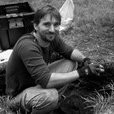
Matthew C. Sanger
- Courses7
- Reviews7
- School: Binghamton University (SUNY)
- Campus:
- Department: Anthropology
- Email address: Join to see
- Phone: Join to see
-
Location:
4400 Vestal Pkwy E
Binghamton, NY - 13902 - Dates at Binghamton University (SUNY): March 2017 - November 2019
- Office Hours: Join to see
Biography
Binghamton University (SUNY) - Anthropology
Resume
2008
Phd
Anthropology
Columbia University in the City of New York
2000
MA
Anthropology
Hunter College
1994
BA
Anthropology
GIS
Field Work
History
Cultural Heritage
Cultural Resource Management
Excavation
Science
ArcGIS
Archival Research
Cultural Anthropology
Ethnography
Museum Collections
Museums
Anthropology
Museum Education
NEPA
Archaeology
Spatial Analysis
Historic Preservation
Surveying
Scaffolds and links
or how to trace staged-learning through a productive chain
Abstract: While learning has recently become a prominent area of research within archaeology
tracing its history and character through objects has proven difficult. This is particularly true when learning is considered a staged event in which novice engagement with objects is intermittent rather than sustained. Learning to make pottery is often staged in that novices assist in particular aspects of the productive chain while more experienced individuals perform other tasks. As such
individual vessels often go through multiple hands
making assignment as “novice-wares” problematic. This paper offers a way forward through the application of a constellation of techniques; each of which provides information on a discrete link in the production sequence and assess the level of skill reflected in particular attributes. By applying these methods to two pottery assemblages from neighboring contemporaneous sites
the shortcomings and potential feasibility of these techniques are highlighted and new research directions are offered.
Scaffolds and links
or how to trace staged-learning through a productive chain
Fibrous Twists and Turns: Early ceramic technology revealed through Computed Tomography
Ceramic technology was independently invented in coastal Georgia more than five thousand years ago. These ceramics are the oldest in North America and are only rarely encountered by archaeologists. A prevailing question is “how were these first ceramic vessels constructed”? While later time periods are dominated by coil-construction
it appears that these early potters used a wide variety of techniques (including molding
pinching
and slab) to construct ceramic vessels. These techniques are not readily visible without using destructive analytical methods. The use of CT technology is beginning to allow archaeologists to uncover past practices without destroying these rare artifacts. This presentation will outline current research and methodology being conducted at the American Museum of Natural History in which non-destructive practices are employed via the use of a GE phoenix v|tome|x s240 CT scanner and reconstructions and post-processing analysis work using GE phoenix datos|x 2.0 and Volume Graphics VGStudio Max 2.1 to investigate: the direction of fibers
abundance of porosity
and three dimensional digital reconstruction of these artifacts.
Hannah Cain
Sanger
Columbia University
Binghamton University
American Museum of Natural History
American Museum of Natural History
Graduate Student
Columbia University
Assistant Professor
Binghamton University
Possible Matching Profiles
The following profiles may or may not be the same professor:
- Matthew C Sanger (60% Match)
Assistant Professor
Binghamton University - Suny Binghamton






